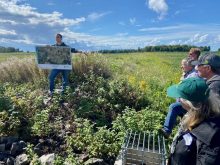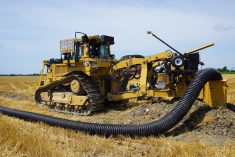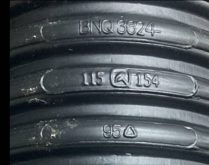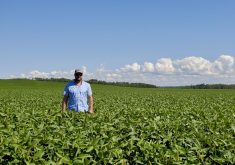Glacier FarmMedia – Two long-term research studies show a significant return on investment of tile drainage in American cropping conditions in the Midwest.
Eileen Kladivko of Purdue University published an update on a 35-year study on a 15-acre plot of poorly drained silt loam soil in Indiana where tile drainage was installed.
When the study began in the early 1980s most of the state’s farmland already had tile drainage because of the high amount of precipitation the state receives, aside from fields with high silt content because this tended to plug traditional clay tiles.
Read Also

The forced Japanese-Canadian farmers of the Second World War
Manitoba’s sugar beet farms drew on displaced Japanese-Canadians from B.C. during the Second World War
Why it matters: The studies were completed in growing regions similar to Ontario and measured yields for corn and soybeans.
“Farmers in that part of the state were asking Perdue when modern plastic perforated drain pipe came out in the 1970s to see if it would work on soils that were poorly structured with low organic matter,” Kladivko said.
She said the study’s key takeaways show that installation of tile drainage is a good long-term investment, it improves timeliness of fieldwork by one to 15 days, corn yields improved and it helps enable other conservation practices to work better such as cover crops and no-till.
The study used a five, 10, and 20 metre spacing of installed tile compared to a control.
“Crop yields (corn) increased, not every year but on average over the 35 years we had a significant yield increase. I think it was around 24 bushels on average,” Kladivko said.
The study did not find a significant increase in soybean yields from the drainage treatment.
She said part of the yield increase came from the tile draining areas in the field where water used to pool and drown out the crop after high precipitation events.
Being able to get on the field and plant earlier on drained treatments also likely provided a yield benefit because the undrained control plots were delayed between one to 15 days for tillage and planting compared to the narrowest drain spacing.
Kladivko said tile drainage helps both cover crops and no-till conservation practices.
“Once you drain the soil then the cover crops grow better, your no-till works better, so you kind of need to deal with drainage issues first before you can be real successful with some of those other conservation practices,” Kladivko said.
Shawn Conley is a soybean specialist at the University of Wisconsin and participated in a separate multi-state tile drainage study that was also recently published.
The study had two main approaches.
“We went out and found colleagues of mine across the north-central region that had replicated field experiments and drainage was the main factor. We had stuff from North Dakota, Minnesota, Iowa and Missouri. Some of this had been published but a lot of that data hadn’t been published yet,” Conley said.
For the second approach, researchers used funding from North Central Soybean Research Program to survey growers for information on about 8,000 farm fields across the north-central region to find out their agronomic practices, yield numbers and whether they reported tile drainage or surface drainage.
“What we found was across the entire region, average (soybean) yields with subsurface artificial drainage was eight per cent higher in the experimental field and four per cent higher (2.3 bushels per acre) in the farmer’s fields,” Conley said.
He said the yield response on the farmer reported data likely came about because they were able to get into the field and plant about a week earlier where tile drainage was installed.
“They could plant seven days earlier. Depending on where you are in the Midwest, we can see up to half a bushel per acre per day yield increase by earlier planting,” Conley said.
– This article was originally published at The Western Producer.














